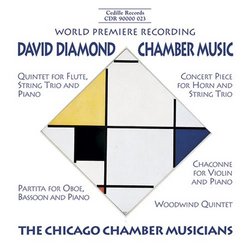| All Artists: David Diamond, The Chicago Chamber Musicians Title: David Diamond: Chamber Music Members Wishing: 0 Total Copies: 0 Label: Cedille Release Date: 10/7/1996 Genre: Classical Styles: Chamber Music, Forms & Genres, Sonatas, Historical Periods, Classical (c.1770-1830), Instruments, Reeds & Winds Number of Discs: 1 SwapaCD Credits: 1 UPC: 789368510726 |
Search - David Diamond, The Chicago Chamber Musicians :: David Diamond: Chamber Music
 | David Diamond, The Chicago Chamber Musicians David Diamond: Chamber Music Genre: Classical
|
Larger Image |
CD Details |
CD ReviewsThe Many Faces of David Diamond J Scott Morrison | Middlebury VT, USA | 02/04/2004 (5 out of 5 stars) "I was surprised that this issue which came out in 1995 has never been reviewed here, although I am grateful that there are some sound clips to give the browsing Amazon shopper an opportunity to hear snippets of the music. This CD features one of my favorite groups, the Chicago Chamber Musicians, which has a changing cast of instrumentalists. In this issue the musicians are Joe Genualdi, violin; Larry Combs, clarinet; Bruce Grainger, bassoon; Michael Henoch, oboe; Deborah Sobol, piano; Rami Solomonov, viola; Gail Williams, horn; Loren Brown, cello; and Mary Stolper, flute. To a man (and woman) they are accomplished players and one could not ask for more of their playing here. It is simply wonderful, full of nuance and life. They give us a generous sampling of the chamber music of David Diamond (b. 1915), composed over a period from 1935 to 1978, in various styles reminding us now of Poulenc, then of Schönberg. The 13-minute neoclassical and tonal 'Quintet in B Minor for Flute, String Trio and Piano' (1937) is in three movements - fast, slow, fast - and sounds as close to Poulenc as any American music I know. There are incisive dance-like rhythms in the outer movements, and the middle movement is a luscious song for the flute and strings that also features some evanescent high notes in the piano and numerous echo effects. The eight-minute 'Concert Piece for Horn and String Trio' (1978), on the other hand, is highly contrapuntal, loosely atonal and densely argued. There are some triadic points of rest but in the main this is a piece that sets off the differing timbres of horn and strings astringently. 'Partita for Oboe, Bassoon and Piano' (1935; about 9 minutes long) takes us back to the neoclassical world of Les Six (even though at the time he was studying with Roger Sessions!). A Partita is usually a dance suite, but that is not the case here. The only thing baroque about the music is the witty counterpoint (of a genial Hindemithian sort) used throughout. The Allegro molto third movement is a whirling perpetuum mobile.The 13-minute 'Chaconne for Violin and Piano' (1948), played gorgeously here by Genualdi and Sobol, is the one true masterpiece on this disc. The opening contains both angular leaps of ninths and sevenths as well as a melodic stepwise motif; these aspects of the opening material figure throughout the set of variations, often playing against each other. There is effective imitative writing pitting the piano against the violin and both parts are virtuosic, but always in the service of musical ends; at times the piano writing reminds me of Copland's 1930 'Piano Variations.' Genualdi really digs in during the dramatic moments, particularly during his cadenza toward the end. This is a work of power, drama and craft. The final piece on the CD is the 18-minute 'Woodwind Quintet' (1958). It was written at a time when Diamond was immersed in the brave new world of Schönbergian serial music. It begins with a clever exposition of a tone row, divided into digestible little fragments parceled out amongst the five instruments. It soon sets out on its own journey that manages, for all the seriality, to sound like no one more than David Diamond. At eight minutes, the middle movement, 'Theme and Variations with Scherzino Interlude: Adagio,' dominates the whole and is breathtakingly assured, describing a satisfying dramatic arc. It is what Diamond calls 'music in the fugal manner,' by which he means that although fugal maneuvers are used, it is not a strict fugue per se. The finale seems at times to be almost tonal. There is lively exchange of material between the instruments that propels the whole thing forward to one of Diamond's wonted witty finishes. Recommended.TT=61:25Scott Morrison"
|

 Track Listings (11) - Disc #1
Track Listings (11) - Disc #1